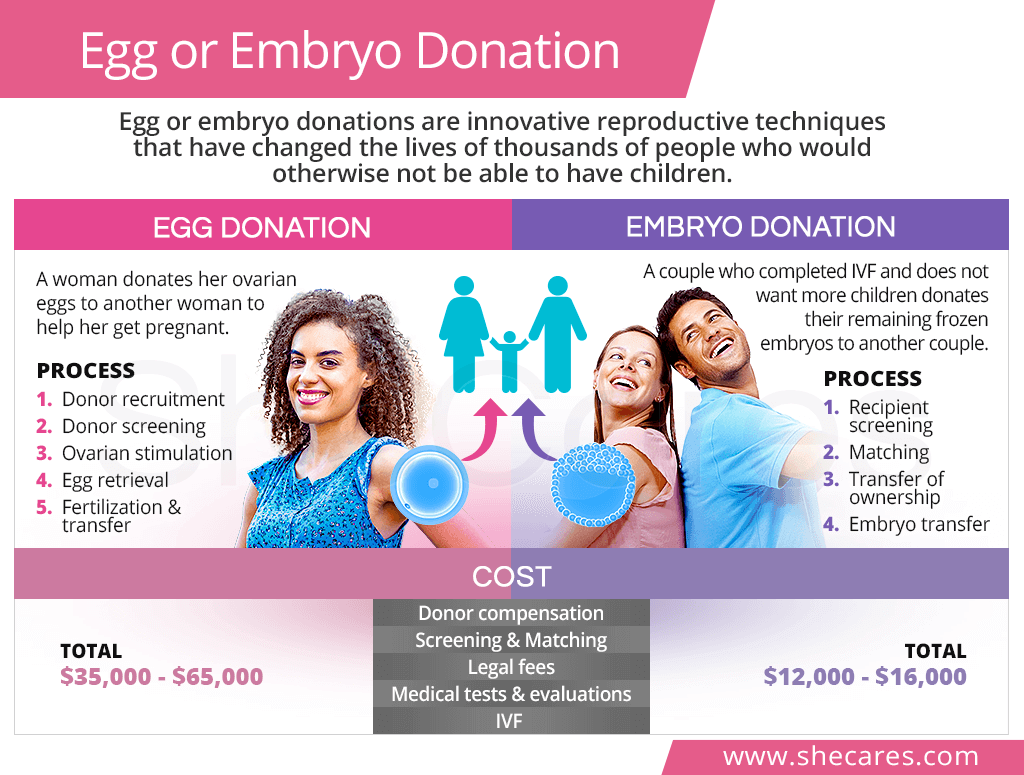What is Egg or Embryo Donation?
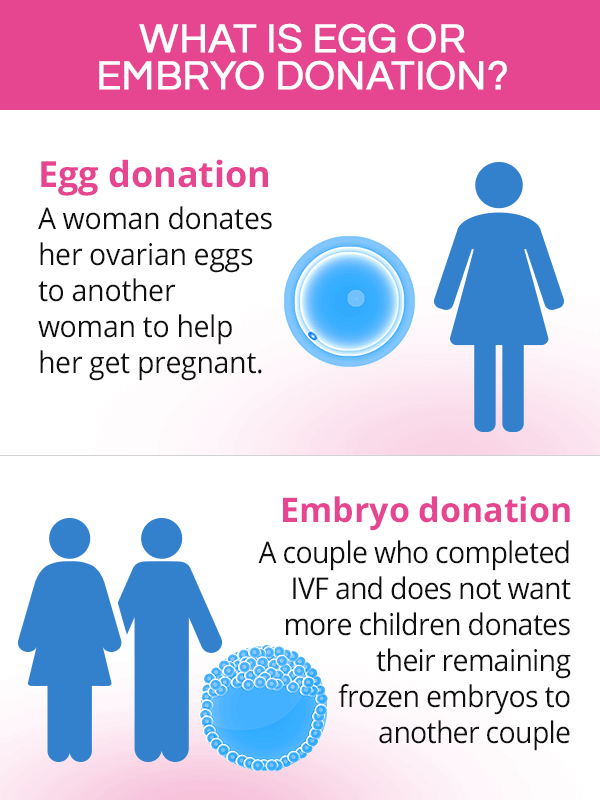
Egg donation is the process of a fertile woman (donor) donating her ovarian eggs (oocytes) to another woman (recipient) to help her get pregnant. Pregnancies using donor eggs always occur through in vitro fertilization (IVF), the most effective type of assisted reproductive technology (ART) for infertility treatment.
Embryo donation, sometimes called embryo adoption, consists of a couple who has already undergone IVF and does not plan to have more children donating the remaining, unused embryos to another couple to help them become parents.
Who Can Use Donor Eggs or Embryos?
Egg or embryo donations are mainly sought after by women in the following conditions or circumstances:
- Cannot carry pregnancy using own eggs
- Poor ovarian reserve
- Menopause
- Genetic conditions
- Unexplained infertility
- Loss, absence, or damage to the ovaries
In some cases, couples who hire a gestational carrier might also consider using donor eggs, donor sperm, or both.
Egg Donation Process
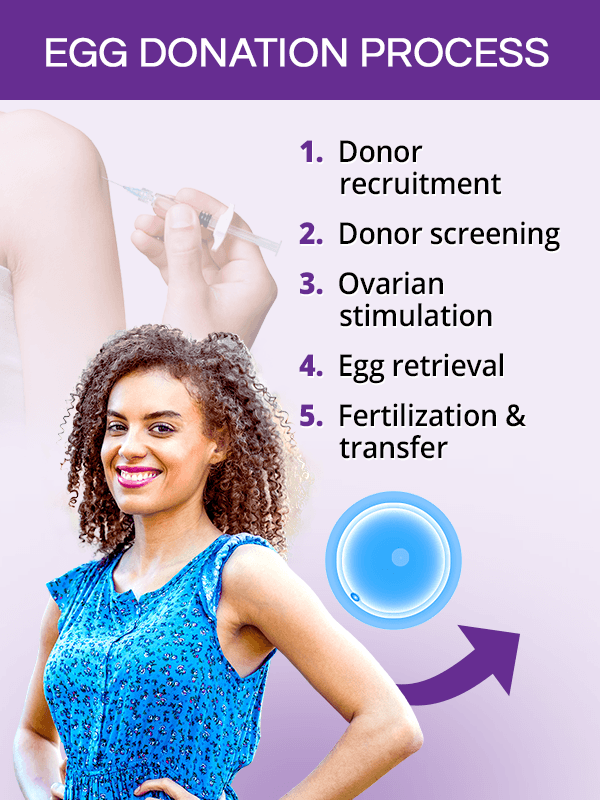
In the majority of the cases, a couple seeking to obtain donor eggs does so through a fertility clinic, although some intended parents are able to find a donor independently among friends or family members.
A fresh egg donation process can take three to six months to complete and consists of the following steps:
Donor Recruitment
Once a couple has specified the characteristics they prefer in a donor, their doctor might help them match the donor in the clinic's database, or a couple might view the profiles of available donors to make the selection. Then, the donor signs a legal contract, which lists her rights and responsibilities and clears her of custody ofthe child that will be conceived using her eggs.
Donor Screening
Only after legal documents for oocyte donation have been signed does a thorough donor screening begin. It comprises of psychological and medical evaluations, the analysis of family history of the last three generations, testing for sexually transmitted diseases (STDs), and genetic testing to rule out hereditary diseases that might be passed on.
Ovarian Stimulation
To make the egg donation procedure more fruitful, the donor has to undergo ovulation induction, which consists of stimulating the ovaries with fertility pills and injections to mature more eggs and synchronizing her menstrual cycle with that of the recipient. At the same time, the egg recipient is treated with fertility medications to prepare the uterus for egg transfer and successful implantation.
Egg Retrieval
When eggs are mature, they can be retrieved from the ovaries through the vagina using a long needle. The procedure is minimally invasive, virtually painless, and takes up to 30 minutes. Although it varies from woman to woman, there are 5 to 15 eggs on average retrieved from the ovaries. This is the final step involving the egg donor.
Egg Fertilization & Transfer
Once harvested, the eggs are fertilized with partner or donor sperm through insemination or intracytoplasmic sperm injection (ICSI). After 3-5 days, the embryos can be transferred to the uterus for implantation. To prevent multiple gestations, typically only one embryo is placed in the uterus, though two or more might also be transferred, depending on a woman's age and reproductive history.
A couple also has a choice of using frozen donor eggs, or cryopreserved eggs, which speeds up the donation process as the eggs are already available for use and stored at the fertility clinic or bank.
Embryo Adoption Process
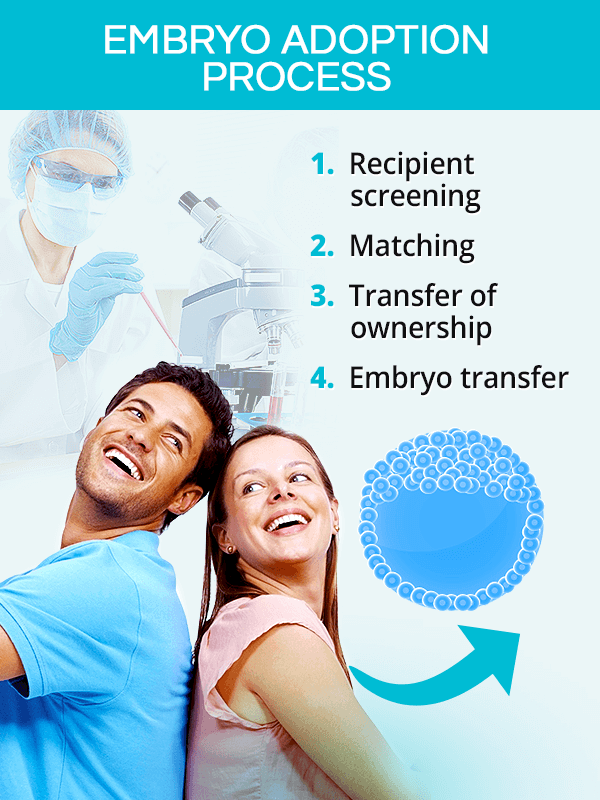
In embryo adoption process all the initial steps of IVF have already been completed by the couple who is willing to donate their unused embryos. However, the process is more regulated because of the embryos' legal status and ethical issues surrounding their handling.
A typical embryo adoption process can take nine to 12 months and include the following steps:
Embryo Recipient Screening
The intended parents seeking embryo donation have to undergo medical screening, which includes blood work and testing for STDs. They also have to participate in the home study, which consists of a state-licensed social worker examining their health, living conditions, and other aspects of life to ensure they are fit to be parents. This process can take 8-10 months.
Donor & Recipient Matching
In some cases, the adopting and donating couples can participate in the matching process based on the information and criteria provided by both parties. In other cases, the process remains anonymous, and the donors are matched with the intended parents by the clinic or an agency based on mutual preferences.
Transfer of Ownership
Before any IVF procedures are performed, the donor couple transfers their ownership right to the embryos to the selected adoptive couple. Although the process is commonly called embryo adoption, the transfer is legally referred to as property transfer, not an adoption.
Fertility Treatment & Transfer
To proceed with IVF, the embryos have to be thawed as they are stored cryopreserved, or frozen. The recipient mother will be treated with fertility medications to prepare the uterus so that it supports the embryo's implantation and fetal development. The final step of the embryo adoption process is their transfer to the uterus.
Egg or Embryo Donation Cost
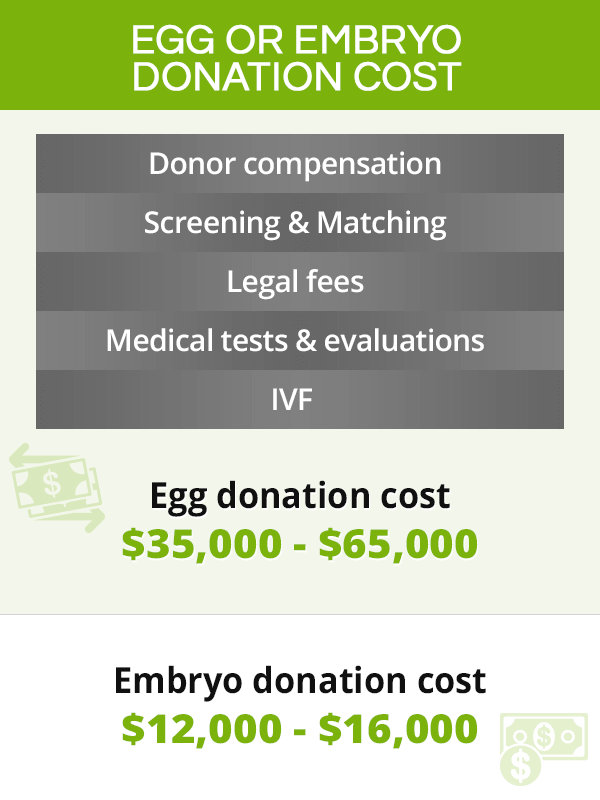
The term “donation” might mislead some into thinking that the process occurs without compensation. Although selling eggs is permitted by law in the United States, selling embryos is illegal. However, there are associated fees charged by the embryo donation clinics or agencies.
Egg Donation Cost
According to the guidelines set by the American Society of Reproductive Medicine, egg donation cost should be as follows:
Egg donor compensation be up to $5,000 with no exceptions
Compensations between $5,000 - $10,000 need a justification
Donor compensations cannot exceed $10,000 under any circumstances
To attract potential egg donors, most clinics and agencies advertise the middle range for egg donor compensation, $5,000 - $10,000 per service, not per number of eggs.
However, a couple using donor eggs pays a much higher price of the entire IVF fertility treatment, including not only egg donor compensation, but also exams and evaluations, fertility medications, and IVF cycles, among other costs. As such, an average donor egg IVF cost can range from $35,000 - $65,000.
Embryo Donation Cost
Because it is illegal to sell or purchase embryos, frozen embryo adoptions are officially processed as donations, though they include numerous and substantial fees paid to the agency or a clinic that handles them.
They consist of the recipient screening, matching, home study, embryo transport between the facilities, fertility medications, frozen embryo transfer, and other legal expenses. As such, an average embryo donation cost varies from $12,000 - $16,000.
Conclusions
Both egg donations and embryo adoptions are capable of changing the lives of thousands of couples who would otherwise not be able to have children. Though more expensive, using donor eggs is less complex legally. Moreover, because of the attractive egg donor compensation, it is much easier to find young women willing to proceed with the donation, making it the preferred method of becoming parents for many couples.
Because of legal issues, embryo adoptions are more complex. Although there are more than 7,000 frozen embryos in storage facilities that might never be used by the couples who own them, it might be challenging for hopeful parents to find embryo donors. Surveys have shown that up to 60% of American couples are more inclined to donate their embryos to science rather than to others in need.
Sources
- AMA Journal of Ethics. (2014). Fully Informed Consent for Prospective Egg Donors. Retrieved March 27, 2019 from https://journalofethics.ama-assn.org/article/fully-informed-consent-prospective-egg-donors/2014-01
- American Journal of Obstetrics & Gynecology. (2016). Creating and Selling Embryos for “Donation”: Ethical Challenges. Retrieved March 27, 2019 from https://www.ncbi.nlm.nih.gov/pmc/articles/PMC4344840/
- American Pregnancy Association. (2019). Donor Eggs. Retrieved March 27, 2019 from https://americanpregnancy.org/infertility/donor-eggs/
- American Society of Reproductive Medicine. (n.d.). Egg Donation. Retrieved March 27, 2019 from https://www.reproductivefacts.org/news-and-publications/patient-fact-sheets-and-booklets/documents/fact-sheets-and-info-booklets/egg-donation/
- Human Fertilisation & Embryology Authority. (n.d.). Using donated eggs, sperm, or embryos in treatment. Retrieved March 27, 2019 from https://www.hfea.gov.uk/treatments/explore-all-treatments/using-donated-eggs-sperm-or-embryos-in-treatment/
- Human Fertilisation & Embryology Authority. (n.d.). Donating your eggs. Retrieved March 27, 2019 from https://www.hfea.gov.uk/donation/donors/donating-your-eggs/
- Human Fertilisation & Embryology Authority. (n.d.). Donating your embryos. Retrieved March 27, 2019 from https://www.hfea.gov.uk/donation/donors/donating-your-embryos/
- JAMA. (2013). Trends and Outcomes for Donor Oocyte Cycles in the United States, 2000-2010. Retrieved March 27, 2019 from https://www.ncbi.nlm.nih.gov/pmc/articles/PMC4307377/
